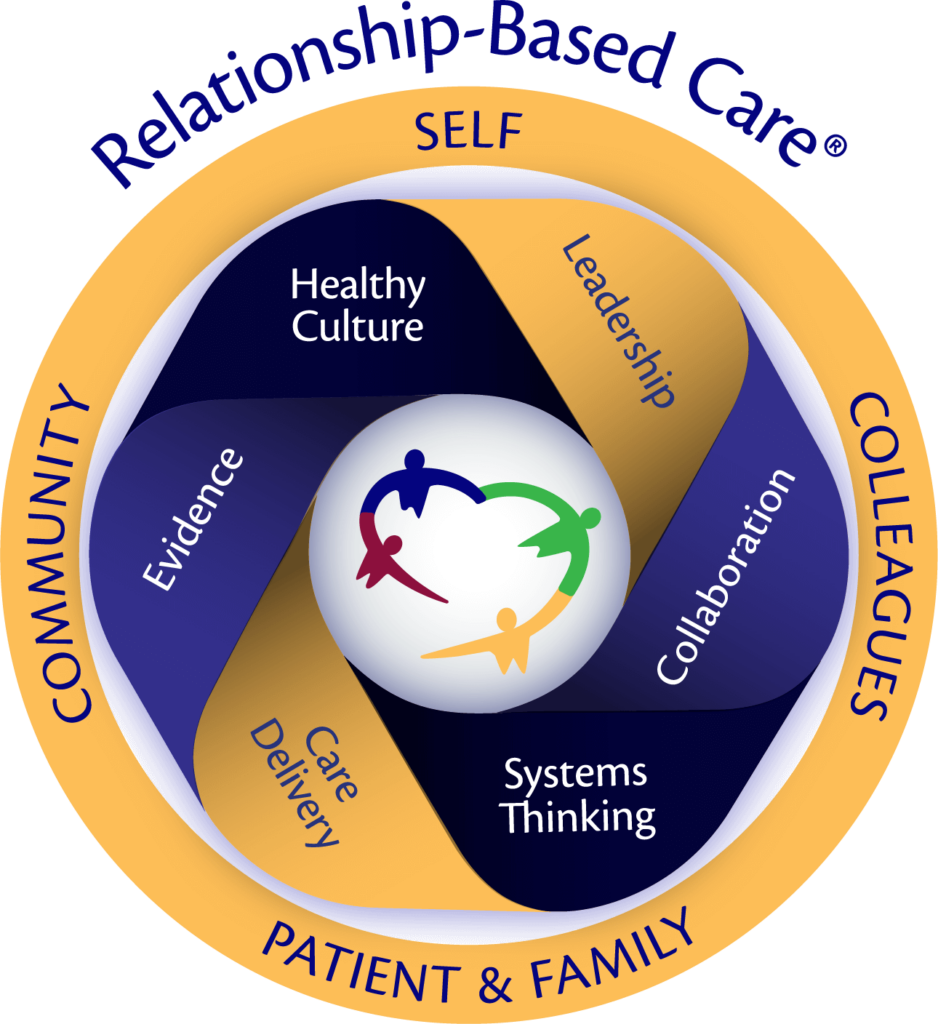Culture is the cornerstone of excellent patient care. And our Relationship-Based Care Model provides the framework you need to transform your culture. By integrating the six essentials of a caring culture, you can create a workplace where employees feel engaged, patients receive the highest-quality care, and your organization thrives.
What are the Six Essentials of a Caring Culture?
The six essentials of a caring culture are the foundation of our Relationship-Based Care (RBC) Model. Integrating these into your caregiving practice is the first step to culture transformation:

- Healthy culture
- Leadership
- Collaboration
- Care delivery
- Systems thinking
- Evidence
1. Healthy Culture
A healthy culture goes beyond treating injuries and illnesses. It builds an environment where patients, families, and employees feel supported physically, emotionally, and psychologically. It’s about treating all people with respect and using best practices to improve the well-being of every person in the organization.
The design of calming spaces, promoting work-life balance, and encouraging open communication can create a supportive environment for all. When organizations cultivate a healthy culture, job satisfaction increases while burnout and turnover decrease. You’ll also notice stronger team cohesion and compassion, which benefits your patients and their trust in the health care system.
2. Leadership
Improving health care culture starts at the top. Leaders set the tone for the organization through inspiration, positive influence, and clear expectations. Leaders both model and encourage staff members to live the mission through their behaviors, supported by the values and strategic direction.
Strong leaders empower their employees, show empathy in decision-making, and foster a culture of collaboration and respect. Under their leadership, staff strive to continuously improve their relationships and processes.
RBC is successful when your leaders model cultural values on a daily basis and can articulate what they appreciate when they notice others modeling those same values. Accountability measures, check-ins, performance reviews, and leadership development programs help your leaders stay committed to sustaining positive change. And when leaders are held accountable, your health care teams become more engaged.
Accountable leaders are more apt to sustain positive change and keep their teams engaged. Engaged teams have improved patient/family satisfaction, are more positive and likely to be innovators, have an increased sense of well-being and workplace fit, higher retention, and an increase in productivity.
3. Collaboration
A shared purpose brings people together. As one of the essentials of a caring culture, collaboration can help the interprofessional team coordinate more effectively to create a healthier workplace culture. When you have mutual goals and include the members who bring value to the outcome, trust, respect, and cohesion among your team become visible and lasting.
A team-based approach helps distribute workloads more evenly, reduces stress and burnout, and provides mutual support for your entire staff. This reduces medical errors and inefficiencies in your day-to-day work. Organizations that prioritize collaboration see higher retention rates and better patient outcomes. Why? Because an engaged and well-supported staff provides higher-quality care.
Interprofessional practice takes teamwork a step further and emphasizes collaboration between doctors, nurses, pharmacists, physical therapists, and other disciplines. We know that clinical professionals are valued for their unique expertise. However, improving health care culture requires moving beyond silos for a seamless experience.
Holistic care brings together diverse perspectives across your organization. Prioritize structured communication across teams, standardized handoff procedures, and treat everyone with mutual respect. When professionals work in a coordinated, patient-focused way, it leads to improved recovery rates and faster response times.

4. Care Delivery
Our goal is excellence in every patient interaction. Developing a structure for organizing care is essential. Consistency in care providers, continuity, and communication are an antidote to the fragmented and inefficient processes that can emerge when we are not paying attention. Successful interprofessional teams intentionally embed compassion, efficiency, and reliability in their care delivery processes.
Of course, this requires aligning staff behaviors with organizational values. The alignment process starts with onboarding and continues with ongoing professional development and leadership modeling. When care delivery aligns with a culture of accountability and excellence, patients notice the difference.
5. Systems Thinking
Systems thinking comes into play to ensure the right team members think together about the best policies, processes, and people to both shape culture and provide a high-quality health care experience. Caring for patients and families does not happen in a vacuum. Health care requires the collaboration of many talented, skilled, and knowledgeable clinicians and support team members, all focused on providing a high-quality health care experience. Interdependence between the various team members and elements of the complex health care system is essential to craft a quality and safe work environment that delivers excellence in patient care.
Systems thinking creates a deeper understanding of the connections, relationships, interactions, and behaviors among the elements that characterize the entire system. Systems thinking encourages owners of processes to go beyond what they know about the process and invite others who are co-owners or recipients of outcomes to be part of the future design.
A well-designed health care system should intentionally support Relationship-Based Care principles. Create workflows that prioritize meaningful patient interactions, lower administrative burdens, and focus on teamwork.
6. Evidence
Evidence may be the most important piece of the essentials of a caring culture. Data provides the insights needed to assess the team’s progress and keep moving forward. Track your desired outcomes to know when you’re achieving your organization’s goals and when to celebrate! Celebrating your success acknowledges the team members who were dedicated and own the processes and builds community and commitment within the organization.
Measurements key to culture are employee engagement, patient satisfaction, and clinical outcomes. The data offer valuable insight about what’s working and where opportunities may exist in your mission towards improving health care culture. With this data, you can make evidence-based decisions to refine strategies.
Implementing Relationship-Based Care in your organization is an ongoing process, but let the successes (both big and small) inspire you to keep working towards excellence.
The Four Relationships
The Relationship-Based Care Model advances your organization by focusing on four key relationships.
1. Patient and Family
High-quality care is patient-focused and family-centered. Patients and their loved ones are the focus of everything we do. The best outcomes happen when patients and their families are included as part of the health care team and participate in care decisions. This approach emphasizes transparency and shared responsibility, ensuring every treatment plan aligns with the patient’s values and needs.
Hospitals embracing this approach experience higher patient satisfaction and reduced readmissions, leading to better health outcomes.
2. Self
Self-care is an essential component of RBC. Ensuring you can effectively serve others means taking care of your own well-being. Monitor your emotions and energy levels as you interact with patients and families. Practicing mindfulness and prioritizing your own health will help you prevent burnout and show up as your best self when caring for others.
3. Colleagues
Your relationships with your colleagues must be rooted in teamwork and trust. This fosters a supportive environment among health care professionals. Modeling open communication and purposeful collaboration promotes a healthy culture, and when teams function cohesively, they create a workplace where innovation, problem-solving, and patient-centered care can flourish.
4. Community
Health care extends beyond the walls of a hospital or clinic. This key relationship emphasizes the role of clinicians in understanding and reacting to the needs of the community. Ensure equitable access to care, partner with local organizations, and support public health initiatives to make a lasting impact. A strong relationship with the community doesn’t just improve health outcomes. It also reinforces the idea that quality care isn’t just about treatment—it’s about creating a healthier future for all.
Why Does Culture Matter?
A healthy culture positively influences the interprofessional team, patients, families, and outcomes. Prioritizing a healthy culture is essential to delivering quality care to your patients, family, and community. Healthy cultures begin from the inside out to make lasting change in your organization and give your staff a voice.
Organizations will discover the benefits of a strong health care culture when intentional effort is put into designing a culture that supports employee engagement, patient focus with greater consistency, efficiency and collaboration, and enhanced clinician-patient relationships.
After carefully addressing and improving each of these essentials of a caring culture, you will achieve organizational excellence. The intentional focus on a healthy culture is an ongoing process, but in doing so, you will see systemic and sustainable results.
See the Six Essentials of a Caring Culture in Action
Before CHCM, Mississippi Baptist struggled with employee engagement and patient satisfaction. Nursing turnover was high, and satisfaction rates were below average. They needed a dedicated partner to walk them through a solution.
The Relationship-Based Care Model provides a framework to strengthen what is going well in an organization and to address opportunities from an appreciative approach. RBC’s all-inclusive nature ensures that every staff member, position, and department has a meaningful role and is included in the cultural transformation.
Our Results:
- Turnover dropped from 21.5% to 13.5%, saving Mississippi Baptist approximately $1.64 million per year.
- Agency staffing costs decreased from $4.65M a year to $0.
- 5 of 9 HCAHPS Composites are in the 90th percentile.
- Nursing and employee satisfaction significantly increased.
- Costs were cut by eliminating shift bidding and RN sign-on bonuses.
“RBC isn’t an initiative that you put in place and then move on to the next initiative. It’s real cultural transformation. We in leadership are ‘get it done’ people. You have to trust the process, appreciate and celebrate every positive change, and keep at it.”
Bobbie Ware Vice President Patient Care Services and Chief Nursing Officer
Ready to Transform Your Culture? We Can Help.
Cultural transformation isn’t easy, and with Creative Health Care Management as a partner, it doesn’t have to feel impossible. The Relationship-Based Care Model points staff and structures toward creating the best experience for patients, families, and caregivers. It’s not just what you do. It is who you are as an organization.
Once you start seeing the benefits of a strong health care culture, you can begin focusing on other critical designations like Pathway to Excellence® and Magnet®. It all starts with the six essentials of a caring culture. Your culture defines your impact, and focusing on these essentials can help you increase satisfaction and patient outcomes.
Culture isn’t just about policies and procedures—it’s about people. Let’s build a culture where excellence is the standard, care is personal, and every individual feels valued. Your journey to a stronger, more connected health care organization starts today.
Kathleen Van Wagoner MSN, RN, MSA
Kathleen is an accomplished mentor and developer of people, programs, and culture. As a highly successful former nurse executive in clinical administration, program design, and project management, she is skilled in all aspects of care provision. She brings to her consulting work an in-depth knowledge of clinical operations, academics, research, and health care finance. She is dedicated to establishing high quality, caring relationships between health care providers and the patients and families in their care.





